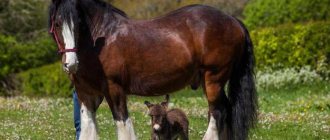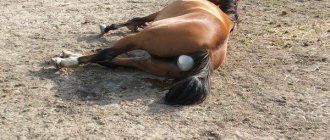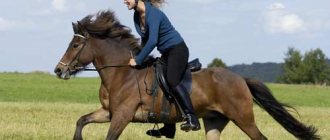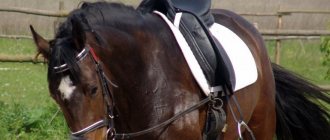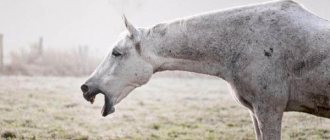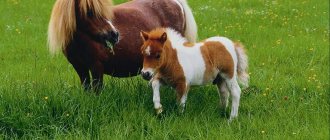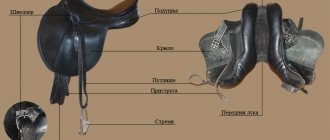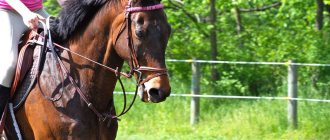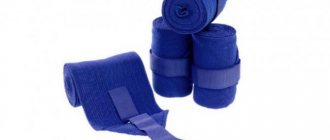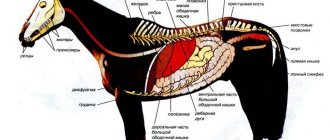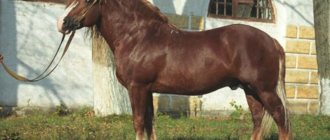Nap on legs
How do horses sleep when they stand on their feet for a long time without getting tired? Zoologists have already studied and explained this mystery of nature. On average, an adult weighs four hundred kilograms. The legs and hooves of animals are under such weight of the body both while walking or running, and during sleep. Why don’t they get tired and withstand such a load?
Horses half asleep
Nature has decreed that when standing, horses evenly distribute their weight across all four legs, the ligaments in the knee joints are tightened and allow them not to feel this load. In addition, they relax all the muscles and slightly bend the lower back. Horse hooves are designed in such a way that the entire weight of the body is taken by the frog (or connective tissue, which has a soft base, shock-absorbing points when walking and running and distributing the load on the hooves). So horses, during the evolutionary process, were able to learn to rest, graze, and save their lives.
Anyone who had the opportunity to observe the graceful animals at least a little could see a standing horse in a sleeping state. The animal's eyelids were closed, the lower back was arched, and the legs were steadily positioned parallel to each other. The head and tail are relaxed, as are the ears. The question naturally arises: do horses really sleep like that?
In fact, in such a state the horse is dozing, that is, the brain and muscles do not completely relax and are ready for action at any moment. This behavior has developed at the genetic level since the times when wild herds were constantly threatened by predators.
To rise from a prone position, the horse will have to spend quite a lot of precious time. When standing, the horse, as they say, is “always ready.” Hence the conclusion that horses rest even when they are on their feet, but this state cannot be called full sleep, but drowsiness.
How do horses rest?
In this video you can find out the truth about whether horses really rest while standing or not.
Even horse owners sometimes wonder if horses sleep. They notice that animals spend most of their time on their feet and lie down very rarely. Experienced breeders know that when a pet feels completely safe, it lies on its side and falls asleep in a peaceful sleep.
Horse owners often find them standing motionless in a stall with their eyes closed. At the same time, the pet can swing its tail and move its ears. It seems that the horses never sleep, because it is rarely possible to see them lying on the floor. It turns out that horses can recover their strength while standing.
Even-toed ungulates spend most of their time in a state of half-asleep. When they freeze with a slightly arched lower back, almost all the muscles relax. This is why horse breeders find their pets in a strange position - with their eyes closed and their ears and tail moving from time to time.
Horses sleep standing up, but their sleep is shallow. Thanks to the special structure of joints and tendons, animals distribute their body weight across 4 limbs, and the load is not felt at all. The horses are completely relaxed, as evidenced by the arch of the spine and drooping lower lip. A horse can remain half asleep for up to 15 hours a day.
Odd-toed ungulates learned to sleep standing up during the process of evolution. Their wild ancestors were often attacked by predators. To avoid becoming their prey, the horses remained alert even in their sleep. Hearing the noise, they immediately took off and ran away from the enemy. Wild horses cannot afford to fall asleep deeply while lying on the grass, otherwise they will pay for their carelessness with their lives and become a predator’s lunch.
Out to pasture
In the wild, you can see herds of horses sleeping with their limbs tucked under them, right in the pasture. It is interesting that the horses take turns guarding while the others are resting. The “duty” mare or stallion lowers itself onto the grass, bending its legs at the joints. The head is slightly lowered.
The animal seems to be sleeping, but the sleep is not deep, but superficial. The horse reacts to sounds and notices the slightest changes in the environment. When he discovers danger, he will inform the others.
Lying on your side
Horses can achieve maximum relaxation and immerse themselves in a deep sleep phase only by lying on their side. This type of rest allows you to quickly restore strength within 2–4 hours. Even-toed ungulates fall asleep in this position if they feel safe, for example, in a stall. A striking example of a serene and sound sleep is provided by small foals. Being close to their mother, they are not afraid of anything, so they can often be found sleeping soundly.
It is very rare to see an animal lying serenely on its side or in another position in a state of sound sleep. The reason for this behavior is explained by the fact that in the past horses were wild and lived according to the laws of the wild: whether they were predators or mammals, they were fed or saved by their legs. Therefore, you need to constantly be on alert so as not to become a victim of wolves or other “lovers” of horse meat.
Sleeping soundly stallions
Instinct still forces horses in camps to gather in a herd and rest there, surrounded by their relatives. Some watch and guard sleep, others rest, standing or lying down. So they take turns guarding each other’s sleep. Moreover, the position in which stallions and mares rest is on their legs bent at the joints.
Interesting! The pose on half-bent legs is very convenient from a safety position. Feeling a threat or hearing a suspicious noise, the horses quickly pull them forward, push off with their hind hooves and quickly take off. This habit was preserved among them and passed on from their ancestors, whose teacher was nature itself.
Elephants are social animals
It has long been noted that elephants are animals that take care of their fellows or pack, in more scientific terms - social animals. Most often, the division into packs of elephants is determined by gender, between adult individuals. The cubs walk with the female elephants until they grow up, then division occurs again.
A flock means a lot to elephants; one might say that for them it is their whole life. Despite the fact that elephants are the largest mammals, individually they are easy prey for various predators and poachers. Due to their impressive size, they are very clumsy, and young individuals are even more unable to fight back in an emergency.
Since ancient times, elephants have been used by humans, not only for hunting for valuable tusks, but also as assistants, circus performers, etc. Due to the rarity of these animals and increased hunting, elephants are listed and carefully protected.
The position in which elephants sleep most often depends on how old they are. So, the cubs, who are completely immature and are still learning everything, usually sleep on their sides, while the adults sleep in a standing position, gathered in a tight ring around the babies so that nothing threatens them at night. Only after making sure that the whole flock is safe do they fall asleep, like a big and friendly family.
However, elephants never sleep all at once; they always leave sentries (depending on the size of the pack, usually one or two elephants) who monitor the perimeter and can wake everyone up at the slightest danger. To prevent enemies from sneaking up unnoticed in the dark, elephants usually prefer to sleep during the day.
When sleeping, old elephants hug a tree to better maintain their balance or sleep on their sides like young ones. Why exactly standing still remains a mystery to scientists. Most explain this by the desire to avoid various influences from the soil, overheating during the day or cooling at night. There is an opinion that this position is convenient in case of a sudden attack, since the elephant is still a clumsy animal and a slow rise, if something happens, can kill it, and in a standing position, it is always ready to fight back. Some believe that this feature of sleep in elephants comes from their possible ancestors – mammoths. They slept standing up so as not to get cold at night, at high negative temperatures in their habitats. Even the existing fur could not save them from hypothermia.
A brain function such as sleep is inherent not only to Homo sapiens, but also to many animals and birds. As practice shows, the structure of sleep, as well as its physiology, in birds and animals does not differ too much from this state in humans, but can vary depending on the species characteristics of a living creature.
From a scientific point of view
From the point of view of animal physiology, several conditions are distinguished:
- half asleep;
- nap;
- deep dream.
After considering each of the conditions, it is easy to distinguish them from each other. The horse spends most of his free time half asleep. This state does not allow you to completely switch off. The annoying fly will be driven away by the tail, and at the slightest suspicious noise the eyes will open. A similar “sensitive” sleep is observed in horses in harness, in a stall or in a pasture.
A half-asleep horse is described as follows:
- The neck is stretched horizontally, the eyelids are lowered, the ears are relaxed.
- The lower lip droops.
- Focus on the forelimbs. The hind leg is positioned at an angle, and the second rests on the toe of the hoof.
- The croup is lowered.
Read more: Oryol Trotter horse breed: description, maintenance, care
In this state, remaining on its feet, the horse relaxes its muscles and rests in a turbulent environment. This may be due to the special anatomy of the limbs - the joints are fixed without active muscle tension.
The next stage is dormancy. It is considered a real, albeit rather superficial, dream. To rest in this way, the horse lowers itself to the ground and assumes a “squatting” position. A dormant horse looks like this:
- The head is raised or lies on the ground.
- All 4 legs are bent and under the body.
In this state, the horse does not completely switch off and continues to react to stimuli with flinching and twitching of the ears.
Attention! The horses quickly emerge from their half-asleep state. When alarmed, the animal extends its front legs and immediately rises.
State of drowsiness (half-asleep)
When a horse feels safe, it doesn't mind lying down to rest. In the wild, there is a division of responsibilities between horses. The animals take turns playing the role of sentry so that the others sleep at this time. The horse remaining on guard simply dozes nearby, ready at any moment to sense the approach of danger.
Drowsiness or half-sleep is the next most intense stage of rest. To do this, the animal needs to lie down. The laying process for equids is complex and causes considerable stress. During half-sleep, the horse assumes a position that can be called squatting:
- legs bent under the stomach;
- the head can be raised or lowered all the way to the ground;
- a sleeping horse continues to react to external stimuli, sometimes twitching its ears sluggishly.
This is already a real dream, although still quite superficial. If she is disturbed in this state, she quickly becomes ready for active action. To do this, the animal extends its front legs and immediately stands up.
Often, adults sleep only in this position. This can be explained partly by the lack of complete peace in the environment, partly by the internal discomfort of animals, which are easily excitable types.
Total relaxation
- The animal lies on its side.
- The hind legs are extended lengthwise.
- The forelimbs are bent.
Horses sleep soundly in this position. It is believed that during this period the animal is very vulnerable, since it takes some time to fully awaken. Deep sleep is characterized by smooth and noisy breathing. Sometimes you can hear snoring near the stables. Eyeballs and limbs may move. The latter allowed scientists to assume that graceful animals dream.
Horses relax with a feeling of complete safety. For example, in a herd there is hope for relatives, and in a stable - for the owners. A few hours a day is enough for them to regain strength and be ready for action again.
The question of how horses sleep is of interest to breeders planning to own these noble animals. The main thing is to provide your pets with a feeling of safety and then the rest will be complete.
Sleep lying down
Even though the horse spends most of the day comfortably standing, like any animal, it also requires adequate sleep. To do this, horses lie on their sides and plunge into deep stages of sleep. You can understand how a horse sleeps in deep sleep by observing foals. As children, feeling safe next to their mother, they sleep on their side. Deep, restful sleep is required for the proper development and growth of the body. However, for an adult horse, sleeping lying down is enough for several hours a day.
For adults, due to their large weight, prolonged stay in a lying position is dangerous to health. After 6 hours of lying down, pulmonary edema occurs.
Horse dreams
Sometimes horse breeders pay attention to the fact that their pets hardly sleep in the stall, lying down. This can be seen at a stud farm, when you quietly walk between the stalls or stalls. There the stallions stand with their eyes closed, their ears and eyelashes twitching slightly. This way they relax and doze off. If the stall is dry and spacious so that you can lie down and get up freely, then the animal will feel comfortable.
They dream too
Another question worries lovers of these beauties: “Do they dream?” Judging by their behavior, when they fall asleep deeply and soundly, dreams come to them. Horses either shudder in their sleep, then “run away,” then snort or neigh quietly. Sometimes they can snore, but this is a property of a purely physiological nature: snoring appears under pressure from the body on the lungs. Scientists suggest that horses dream in color because their vision is colored.
Sleep is necessary for every living creature. For what? By resting in our sleep, we restore our strength and receive an additional boost of energy to continue our life. In animals, as in people, sleep comes when the body requires rest. But everyone sleeps differently: people lie in bed, dogs and cats, as well as all representatives of their species, rest curled up, and horses spend most of the day on their feet, half asleep.
On a note! If horses live at home and rest in a stall, then they can sleep either on their side or while standing. It all depends on the situation. In herds, horses rest in their sleep as the wild nature “taught” them. If an animal is healthy, energetic, well-groomed, it means that it has excellent nutrition, good care and healthy sleep.
What a delight the circus riders are when they ride out, sitting or standing on a horse! Every owner of a miracle horse who competes at the races experiences no less joy. Even communication with a simple hard-working horse who plows the land and carries water in the village evokes respect and reverence for him.
How do horses sleep?
How do horses sleep? Many livestock breeders believe that horses can only sleep while standing. However, this is often not true. You will learn about how horses actually sleep in our article.
Those who are familiar with horses often notice that the animal stands in a stable or in a meadow with its eyes closed, one of its hind legs tucked under itself. A sleeping horse can brush away blood-sucking insects without opening its eyes. The horses are not completely asleep. This state can be compared to a light nap.
Pets actually live in a standing position most of the time. Therefore, when possible, they doze. This possibility remains from wild ancestors. In nature, predators could easily find a herd, so sleeping horses could not afford to lie on their sides. It took several precious seconds for sleeping horses to get to their feet, and this, in turn, could cost their lives.
Horses have a special structure of their knee joints. If animals want to rest while standing, the body weight is evenly distributed over four legs, the bones and ligaments are, as it were, “pinched,” and the joints themselves are blocked. Therefore, horses do not feel heavy, even spending a long time on their feet. The muscles completely relax at this time.
A sleeping horse is easy to distinguish from one that is simply standing - the animal’s head is lowered, the lower back is arched, and the legs are straight and parallel. Due to relaxation, the tail tip lowers slightly and the lower lip droops. However, this is not a complete rest for the horse. Like other mammals, horses need adequate sleep on the ground or bedding. Therefore, we can say that horses sleep both standing and lying down. It is impossible to give a definite answer to this question.
In any case, the horses do not sleep very soundly, waking up to flee at the slightest rustle. Sick or old horses sleep standing up because they have difficulty getting up. Young animals like to rest lying down. In herds, one individual usually “keeps watch” and warns the others in case of a threat. When rising, animals first stand with their front legs and then jump up sharply.
Many have noticed that these animals can stand for some time with their eyes closed, while moving their back leg. Because of this, the conclusion arose that horses can spend time sleeping in an upright body state. The horse at this moment is calm, practically does not respond to anything, sometimes twitches its tail and ears.
This behavior suggests that the animal is in sleep mode. But this statement is not entirely true. Horses in a standing position enter dormancy, but not sleep. The knee joints of these animals can be fixed in the area of ligaments and bones, thereby creating a block and immobility.
Read more: “Girl” grapes: propagation by cuttings in spring
How do wild horses sleep - lying down or standing?
Wild horses sleep standing up
Imagine that there is a wild horse in front of us, in 99 cases out of a hundred it will sleep standing up. This is due to the likelihood of attacks by wild animals, for example, on a herd of mustangs. The second delay it takes for the horse to take a vertical position can cost him his life. Therefore, wild animals prefer to rest while standing.
- Legs stand deliberately straight, parallel to each other
- The lower back is arched, the body is relaxed, the tail hangs
- Head tilted
- Gently wiggle your ears to “locate” the natural world around you
To understand which pets need normal rest, you need to look at small foals. Babies almost always rest lying on their side when they feel safe next to their mother. Experienced horse breeders are not surprised when they find adult pets in the same position. It has been noticed that mature individuals often lie with what is called “throwing their hooves away.” Sleeping horses can even snore and it is clear from the movements of their closed eyes that they are dreaming.
Zoologists have researched that only by lying on their side, with their neck and head relaxed, can horses rest in the deep phase of sleep. In this way, a person’s dreams are similar to how a horse sleeps, since in the fast phase the brain does not rest well. True, due to the thin leg bones and decent body weight, horses cannot lie on their sides for a long time.
Thus, if you notice on your farm that a horse sleeps standing or lying on its side, you will understand the nature of the process. In the first case, it’s a deep, healing rest, in the second, it’s just a nap. In general, horses are fully relaxed for about three hours a day, and spend the rest of the time on their feet. Pets can fall asleep only when they feel completely safe.
If your horse never rests on his side in the stable, it means he simply cannot relax. Inexperienced horse breeders believe that the best place for their pets to rest is a stall, closed on all sides. Although you can see for yourself how horses actually sleep in it. Pets have poor rest when alone and in cramped spaces, since horses are social animals by nature.
A closed space, in their opinion, is fraught with danger, and it is much safer to be in contact with relatives (as it was in the herds of wild ancestors). In fact, if an individual is alone in the stall, then it takes on the duties of a “guard.” Take a closer look at how the horse sleeps in your premises - it should not be frightened by loud noises and rustles.
A person needs about eight hours of sleep to fully rest. For horses, only 3-4 hours are enough. Statistics show that pets spend from six to fourteen hours half asleep. In this case, the time of short naps lasts for several minutes at a time. If you provide animals with such a regime, only a couple of hours of sound sleep will be enough for them to fully restore their body.
Take a closer look at how horses sleep. If you notice that a horse in the stable is lying and sleeping in front of you, this means that it is calm about itself and does not feel threatened. True, horses also have their own character. There are particularly impressionable or suspicious individuals who can truly rest only at night, when the room is quiet and there is no one around.
We create optimal conditions for your pet to have a good rest
The quality of rest for the inhabitants of the stable depends on the conditions created for the animals by a responsible person.
Safety
First of all, you need to make sure that the floors in the stable are kept in order. Rotten boards can cause injury to the animal. Fractures and tendon sprains lead to serious consequences for the health of a frisky pet.
Often, due to poor sanitation, the room is simply poisoned by the smell of ammonia. The stench is especially acute at the bottom, at a level of 40-50 cm from the floor. For this reason, horses ignore deep sleep; they simply cannot lie in such an environment. Breeders know what troubles a horse’s “blockage” can bring. In this case, the animal is capable of being fixed in a lying position for a long time. Under its own weight, the horse will develop lung problems. In order to prevent blockages, the stall is equipped with special slopes.
Music
The quiet, melodic composition has a calming effect on pets and helps establish contact between people and animals. Most horses prefer classical music. Some compositions serve as an aid for practicing the trot in animals. Unfortunately, to please customers, unscrupulous stable owners play loud music. The hearing system of four-legged pets is much better developed than that of humans. Loud sounds have a negative impact on the mental state of animals. Horses become nervous, irritable and uncontrollable. In addition, excess decibels can cause colic in the horse.
Company and comfort
Once alone, even a healthy horse can refuse deep, long sleep. The animal is stressed and does not feel safe. A horse needs constant communication with its brothers. Even when walking individually, a horse must see its own kind. Compliance with a walking regime and constant contact with relatives will bring the animal back to normal.
In order for your pet to feel comfortable, you need to place it in a spacious room. The area of the stall should allow the horse to lie comfortably on its side and stretch its legs. The horse spends a lot of time indoors; it cannot live in close quarters.
Particular attention is paid to the lighting of the stables. Graceful animals should not be in the dark
The stable is designed so that there is at least 1 square meter per pet. m windows. The premises must be regularly ventilated.
Why does a horse sleep standing up?
A horse can most often be found exclusively in a standing position, which is why people have a question about the position of the horse’s body during sleep. It has been observed that while dozing, horses close their eyes and raise one hind leg. In such a stance, the animal practically does not react to anything, only sometimes moving its lips and ears.
Why does a horse sleep standing up? On the one hand, this is a typical body position for horses during sleep, but in this way they rather doze off, but do not sleep soundly. Why is this happening? Everything is very simple. When a horse is in an upright position, due to its unique stifle structure, it distributes its entire mass over its four legs and has virtually no sense of where it is standing.
The condition when the horse has a slightly arched back, a slightly lowered head, a tail towards the floor and a slightly drooping lower lip indicates that the horse is in a state of half-asleep.
Why do horses sleep standing up during the day? They just always want to be on the alert. It's in their DNA. Horses are children of the steppe and wide fields, and since there are always enough predators there, even in a state of “sleep” they should be safe.
Safety for these animals is the most important rule. Instinctively, a horse feels unsafe in the place where a person is kept, so it takes measures so that at the slightest suspicion of danger, it can quickly take off and run away, protect itself from dangerous predators or other threats.
Under natural conditions, such a threat haunted these animals constantly. Napping allows the horse to rest at any moment, get out of it very quickly and run forward. In the case of horizontal sleep, it would take more time to wake up and get up, which could affect the survival of animals. Therefore, horses choose to rest upright most of the time.
Many have observed this picture when a horse is standing, but its eyes are closed. At the same time, she waves away annoying insects and barely moves her ears. It is this state that people mistake for sleep. Why does a horse sleep standing up?
In reality, the horse only rests in this way. At such moments she is in a drowsy state. This can be called superficial sleep. These animals inherited the skill of dozing for hours from their wild ancestors.
As a rule, drowsiness is accompanied by the following external signs:
- Head down;
- The lower back arched;
- The tail also droops;
- The lower lip droops;
- Legs stand parallel.
Standing sleep can be observed at moments when horses are grazing. When some of them are merrily frolicking or nibbling grass, another group of animals freezes and thus rests. Horses can remain in this state for 12 hours a day.
Despite the fact that horses and mares spend most of their lives standing, they have learned to relax in this body position. At the moment of falling asleep, their weight is evenly distributed on all limbs, the knee joints and ligaments are blocked. After this, the muscles begin to relax. The horse does not feel its weight in this position and can take a nap, disconnect from external stimuli and relieve fatigue.
Read more: Mouse horse color description and characteristics of the color, appearance and origin
Being in a standing sleep state, animals have the opportunity to wake up easily. At the same time, if nothing disturbs them, they can sleep for long hours. It was this condition that became the source of the myths that horses sleep standing up.
You can see which animal sleeps standing up, like a horse, without leaving your region. Many people who like to take their children on Sunday walks in the parks have probably seen a close relative of horses, the pony, sleeping. There is a whole list that lists which animals sleep standing up. Of these we can mention:
- Cows;
- Goats;
- Giraffes;
- Elephants and others.
In the natural environment, a herbivore has to constantly fear predators. During sleep, the horse is almost defenseless. To get to her feet, she will need time, which is quite enough for a predator to attack. Therefore, the horse allows itself to get a good night's sleep only if it feels completely safe. At other times, she stands and dozes with her head down, sometimes wagging her tail and twitching her skin.
Why does my pet never sleep?
Lack of proper rest affects the health of pets. If the owner of a horse never manages to catch him sleeping on his side, this means:
Horses cannot relax and switch off if they have little contact with their peers or are rarely outdoors. Lack of lighting also causes stress. Exceeding the norms of physical activity is one of the factors affecting the mental state of animals. Having eliminated possible reasons that prevent the pet from relaxing, the owner will certainly find him peacefully sleeping.
Do horses dream?
Scientists say that horses dream. This is evidenced by chaotic movements of the eyelids, twitching of the lips and limbs. Since these animals have color vision, there is reason to assume that they also see dreams in color.
Horses sleep differently than we do. Due to the special structure of the leg joints, they are able to partially restore their strength even while standing, but they still need deep sleep in a lying position. To ensure that horses get enough rest, it is important to eliminate sources of stress and discomfort.
Kira Stoletova
Many habits and habits of animals are incomprehensible to people, so it becomes interesting why things happen this way and not otherwise. For example, one of the most amazing and interesting facts that is interesting to many people is how horses sleep, lying down or standing up.
Safety
How a horse sleeps, standing or lying down, depends on the situation that it itself assesses. Much depends on its location. When in an open area or indoors where she is uncomfortable, the filly will stand. All her instincts will be constantly on guard, telling her at what moment to run and hide away from danger, which in the wild can appear at any second. The animal is able to emerge from this state of half-sleep immediately.
If the horse was sleeping on its side, then it would take him time to get up. In addition, in this position the horse is in danger and can become easy prey for a predator. An animal can sleep on its side only if it feels safe and knows that it is not in danger.
Best sleep on your side
But this does not mean that sleeping on your side is not necessary. On the contrary, only he is complete for this creature, while a standing horse is more likely to simply rest and restore its strength. The best option is to make sure you are safe and lie down. It is believed that otherwise the deep sleep phase cannot be achieved - which means that if the animal does not lie down, then it simply risks not getting enough sleep. It is difficult to escape from a predator when you are sleepy. Therefore, horses sleep lying down only if they are confident in their safety - and this is quite difficult to verify, especially if there is no herd of relatives around who can warn of danger if it arises.
Sleep norm
According to experts, the time frame for horse sleep is very different from human sleep. How the horse sleeps determines how long it will rest. Horses sleep standing or lying down depending on their level of fatigue and feeling of safety. For an animal in a lying position, even a couple of minutes is enough for complete recovery.
- If the animal is very tired, then the maximum time it can sleep is 3-4 hours. But when the horse is standing, he can doze for 15 to 20 hours, but even so, sometimes he is not able to fully compensate for the lack of strength. A horse that suddenly wakes up can be aggressive because it does not understand what is happening. That is why experts say that at least once every two days (maximum - every three days) the animal should sleep lying down. This position is the most advantageous, since in this way the entire balance of the animal and its energy are replenished.
- An interesting fact is that a horse from a state of slumber can instantly regain consciousness and be in full combat readiness, therefore, even if a horse sleeps standing for 16 hours a day, once an hour for 10 minutes the animal will come out of slumber, which means its sleep not that strong, which is very bad for a horse. A sleeping horse does not feel danger. A horse that does not get enough normal sleep and cannot restore its strength that was spent during the day becomes lethargic. The animal is constantly unwell. And one day it may simply fall off your feet and not get up. A sleeping horse is the easiest prey.
- In addition to the fact that they are constantly in danger, there is another reason why horses spend little time sleeping. Horses have a large body mass, but their bones are thin, which is why they cannot lie down for a long time. In addition, if a sleeping horse lies for more than 6 hours, this will lead to pulmonary edema. That is why the maximum time a stallion can spend lying down is four hours. Horses see dreams in the same way as people. If you ever see a horse sleeping, watch it. Its pupils will move back and forth, like a human's, which indicates that the horse is currently watching its sleep. Everyone wants to relax after a hard day.
- Sometimes you can catch horses running in their sleep. It is at this moment that the animals’ legs begin to actively move. What dreams a horse sees remains a big mystery.
Many people have a question, and it can be asked not only by a child, but also by an adult, how horses sleep. There are many assumptions about how sleep occurs in these animals. Therefore, it is necessary to find out exactly which of these statements is true and which is fiction.
Read more:
- The most interesting facts about horses
- The fastest horse in the world (55 photos): what breed, record horses
- Whooper Swan: photo, description, interesting facts
- Mandarin duck - the brightest and most beautiful duck on earth
Sleep lying down
During sleep, horses snore, grunt or whistle. The breathing is smooth and noisy. While in deep sleep, the animal becomes vulnerable, because... It takes some time to wake up. In the lateral position, the horse achieves maximum relaxation and quickly enters the deep sleep phase. Such rest is necessary for the animal, because... it allows you to quickly restore strength. Resting horses in this position has important limitations:
- The horse is never in a lying position for more than 6 hours. Due to the small thickness of the ribs and the large weight, there is a lot of pressure on the lungs. When lying on the side for a long time, their swelling develops.
- Horses should not lie for long periods of time on cold, damp ground. The animal may develop pneumonia.
If a domesticated horse does not sleep lying down at all, this may indicate an incorrect walking schedule or inappropriate lighting. The presence of stress or insufficient contact with relatives can cause sleep while standing in the absence of proper rest while lying down.
To fully restore strength, the animal must be ensured that there are no irritating factors. When surrounded by neighbors, horses sleep more peacefully, because... are herd animals. A good ventilation system must be provided. The stalls should not be dirty or damp; the stable should be maintained at a comfortable temperature and lighting.
>
